Billionton Systems USBBTC1A0 Bluetooth USB Adaptor User Manual Bluetooth Application Note
Billionton Systems, Inc. Bluetooth USB Adaptor Bluetooth Application Note
Contents
- 1. users manual 1
- 2. users manual 2
- 3. users manual 3
- 4. users manual 4
users manual 1
Bluetooth Application Note
FCC Interference Statement
This equipment has been tested and found to comply with the limits for a Class
B digital device pursuant to Part 15 of the FCC Rules. These limits are
designed to provide reasonable protection against radio interference in a
commercial environment. This equipment can generate, use and radiate radio
frequency energy and, if not installed and used in accordance with the
instructions in this manual, may cause harmful interference to radio
communications. Operation of this equipment in a residential area is likely to
cause interference, in which case the user, at his own expense, will be
required to take whatever measures are necessary to correct the interference.
CE Declaration of Conformity
This equipment complies with the requirements relating to electromagnetic
compatibility, EN 55022/A1 Class B, and EN 50082-1. This meets the essential
protection requirements of the European Council Directive 89/336/EEC on the
approximation of the laws of the member states relation to electromagnetic
compatibility.
FCC Notices
This device complies with part 15 of the FCC rules. Operation is subject to the
following two conditions:
(1)This device may not cause harmful interference, and
(2)This device must accept any interference received, including interference that may
cause undesired operation .
“FCC RF Exposure requirements:
This device and its antenna(s) must not be co-located or operation in conjunction
With any other antenna or transmitter.”
NOTE: THE MANUFACTURER IS NOT RESPONSIBLE FOR ANY RADIO OR TV
INTERFERENCE CAUSED BY UNAUTHORIZED MODIFICATIONS TO THIS
EQUIPMENT. SUCH MODIFICATIONS COULD VOID THE USER'S AUTHORITY TO
OPERATE THE EQUIPMENT.

Index
1. Bluetooth software installation and basic operations
Application note for Windows 98/ME/2000/XP:
2. Network sharing setting for Windows
3. File transfer setting for Windows
4. Dial-up networking setting for Windows
5. FAX setting for Windows
6. PIM Item Transfer setting for Windows
7. Information Synchronization setting for Windows
8. Serial port setting for Windows
9. ActiveSync setting for Windows
10.Audio Gateway setting for Windows
11.Personal area network setting for windows
Installing Bluetooth software for WinCE
Application note for WinCE:
1. Network sharing setting for WinCE
2. File transfer setting for WinCE
3. Dial-up networking setting for WinCE
4. Serial port setting for WinCE
5. ActiveSync setting for WinCE
6. Hosting a Personal Area Network for WinCE
Installing Bluetooth on MAC O.S.
How to pair with my mobile phone
1. How to pair with Nokia 6310
2. How to pair with Nokia 8910
3. How to pair with Ericsson T39m
4. How to pair with Ericsson T68
5. How to sync with Ericsson T68 via XTNDConnectPC
6. How to sync with Nokia 7650 via Nokia PC Suite for 7650
Others Applications:
1. How to setup HyperTerminal for Bluetooth transfer
2. How to HotSync with Palm Bluetooth SDIO/ Palm Tungsten T
3. How to dial-up from Palm Tungsten T to my PC's modem to surf the
Internet
Troubleshooting
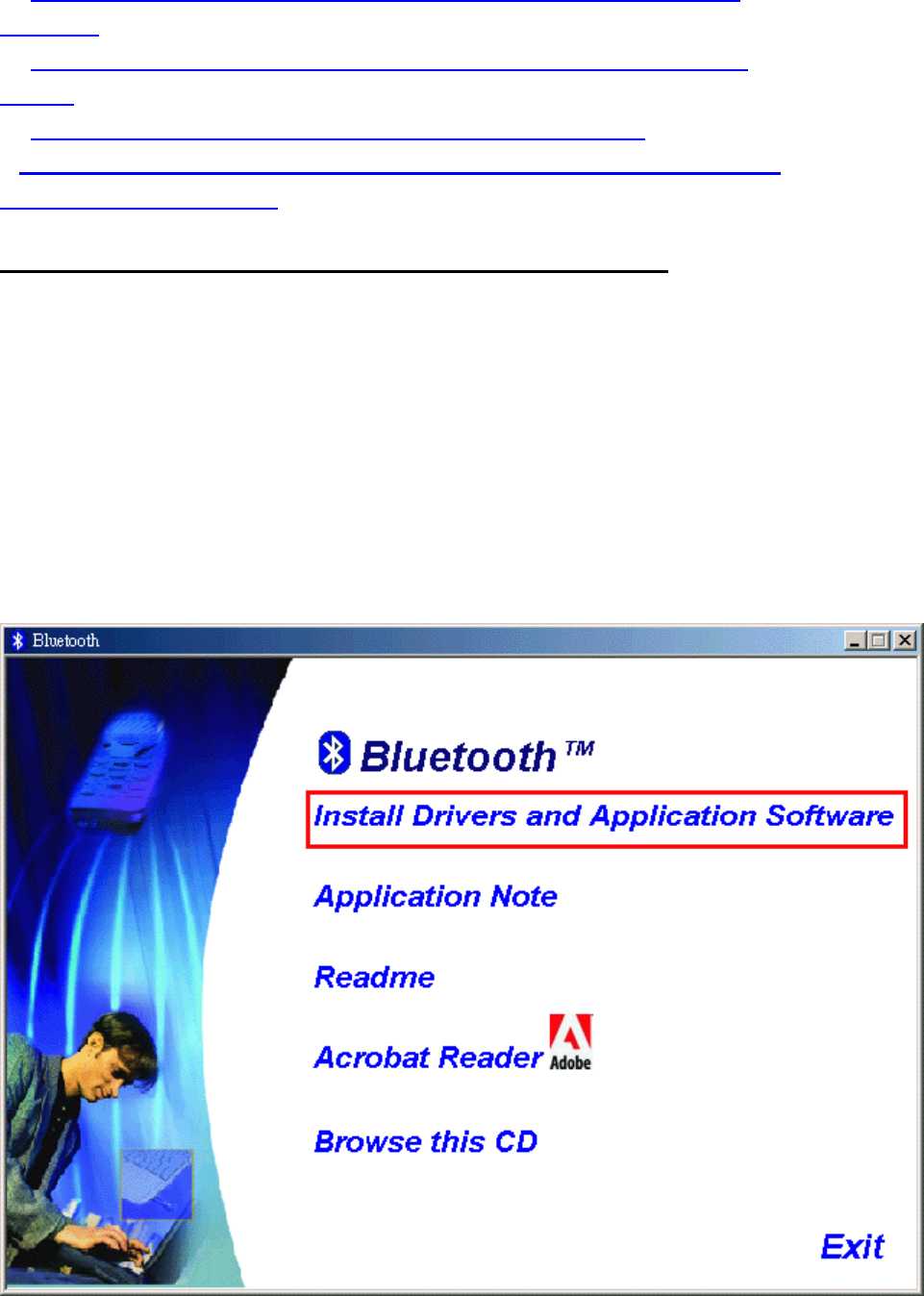
Q1. Why doesn't my Bluetooth device find any nearby Bluetooth
devices?
Q2. Why doesn't my CF card work after I unplug and later plug-in
again?
Q3. Why can't I transfer files from Nokia 7650 to my PC?
Q4. Why some devices within connection range may not show up in
the list of devices found?
1.Bluetooth software installation and basic operations
For CF Bluetooth card please install the driver before installing
Bluetooth software, the driver can be located in BTCF of the
driver CD.
For USB Bluetooth adapter please install Bluetooth software
before inserting the USB adapter.
Installing Bluetooth software for Windows
(1) Place installation CD into PC and setup should launch automatically.
If setup does not launch, use Windows Explorer to navigate to the appropriate
CD-ROM drive and run "Bsetup".
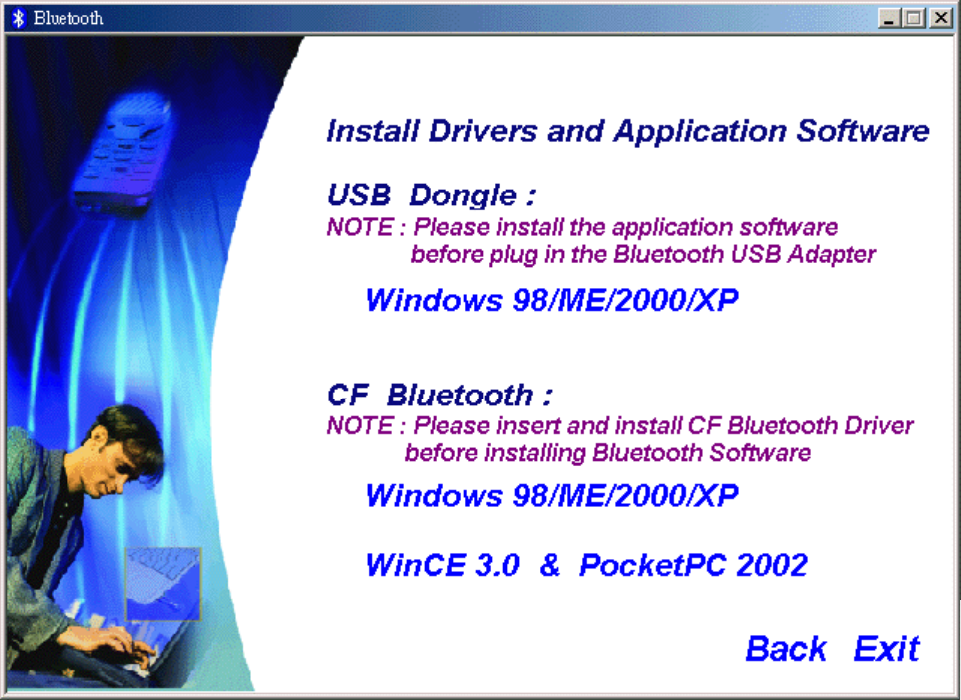
(2) Please select your device and O.S..
(3) Complete these steps to install Bluetooth software:
(4) Exit all applications.
(5) InstallShield Wizard setup dialog box will automatically be displayed. If the
setup program doesn't startup automatically, manually start the setup program
by double clicking Bsetup.exe.
(6) Follow the instructions on screen:
(7) On the Welcome screen, click the Next button.
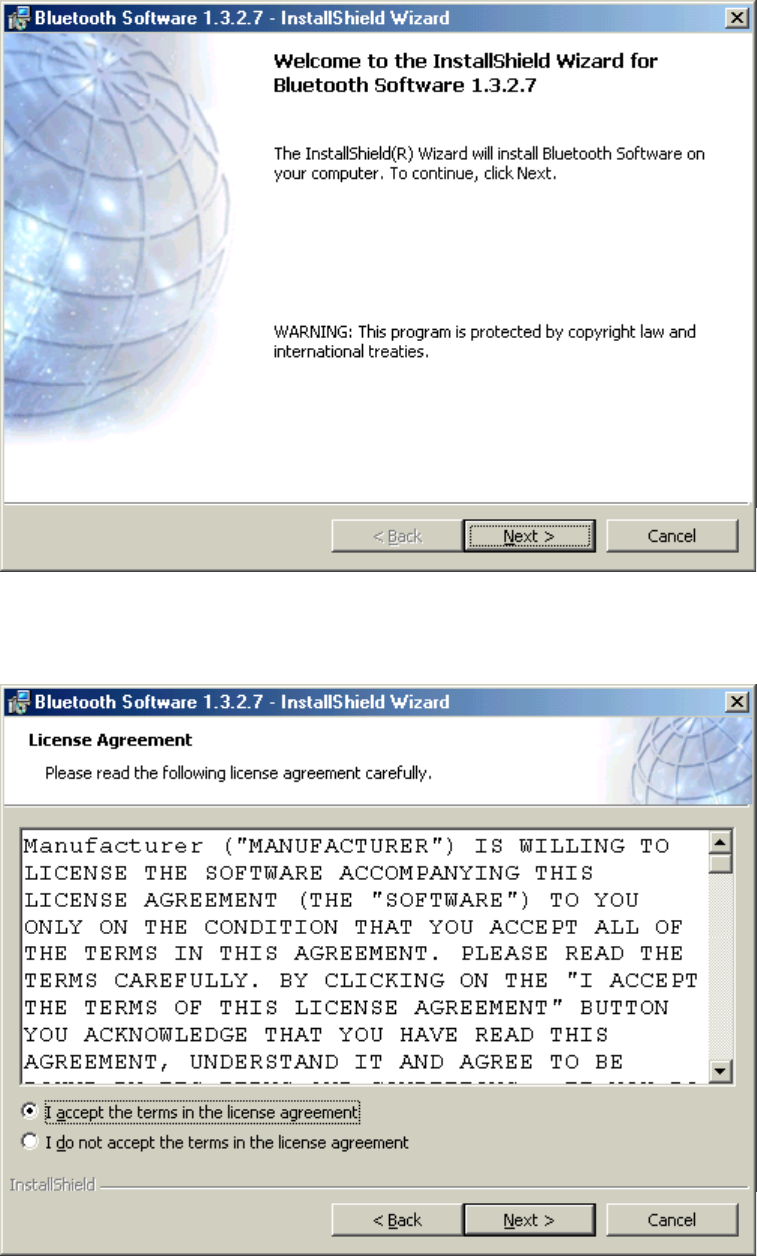
(8) When the License Agreement screen is displayed, read the License
Agreement, then click the radio button to the left of "I accept the terms in the
license agreement" and click the Next button.
(9) You can choose the destination folder in your system, If you do not want to
change the destination folder please click Next.

(10) On the Destination Folder screen, click the Change button to browse to a
new destination folder for the Bluetooth software. Otherwise, click the Next
button to accept the default folder.
(11) The system is ready to install the Bluetooth software. If you need to review
or change any settings, click the "Back" button. Click the "Cancel" button to
exit the Wizard. Otherwise, click the "Install" button.
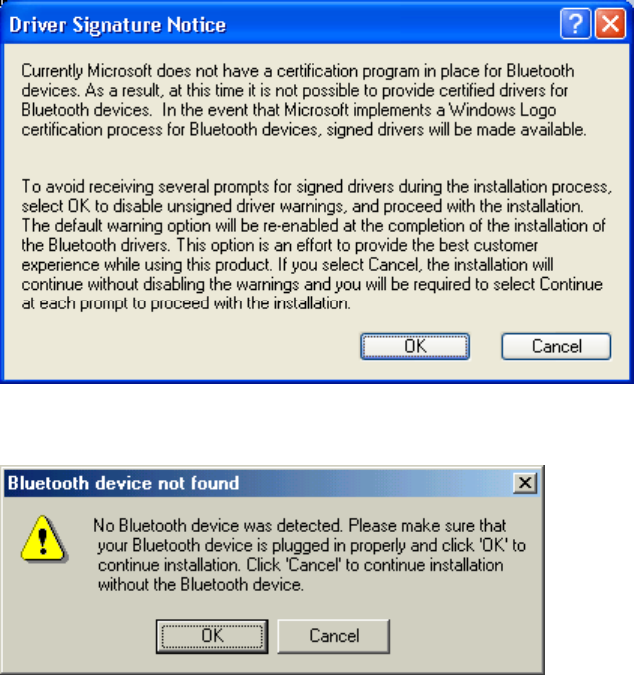
(12) For Windows 2000/XP users, system will popup a "Driver Signature
Notice", please click the "OK" button.
(13) During the installation, system will detected your Bluetooth device please
make sure your Bluetooth device is plugged in properly and click "OK" to
continue installation, or you can click "Cancel" to continue installation without
the Bluetooth device.
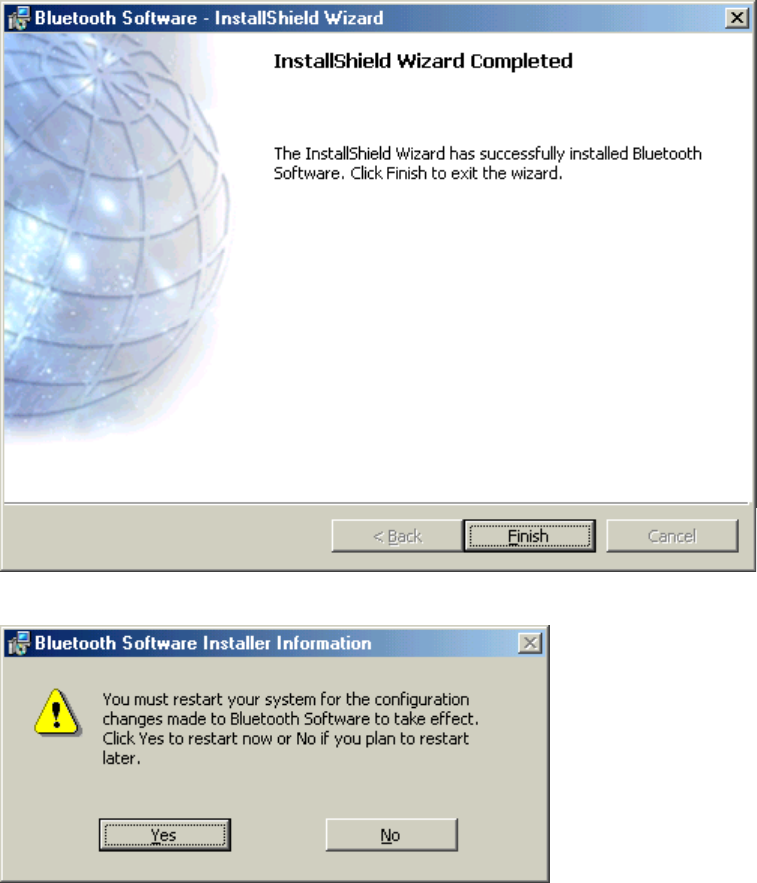
(14) Installation completed please click "Finish".
(15) Click "Yes" to restart your computer. If you plan to restart later, click
"No".
(16) After reboot and Windows comes back up again, insert your USB
Bluetooth adapter into the PC's USB port, if you haven't done so during the
installation, and the system will install the driver for your device automatically.
(17) Do not reboot. Your device is now ready to be used.
(18) To start Bluetooth: in the Windows system tray, right-click the Bluetooth
icon and
select "Start Bluetooth Device". The Bluetooth icon is blue in color with a
white insert
when Bluetooth is running.
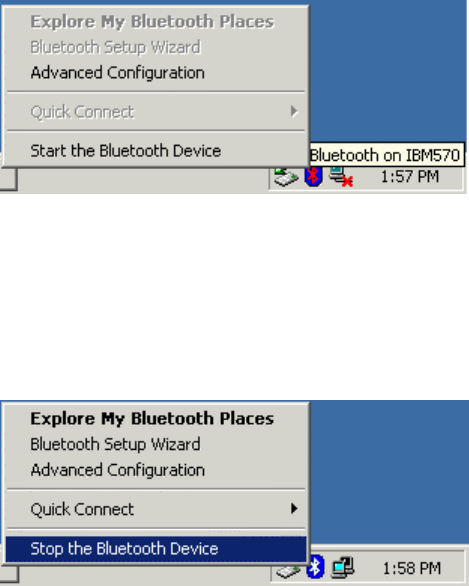
(19) To stop Bluetooth: in the Windows system tray, right-click the Bluetooth
icon and select
"Stop Bluetooth Device". The Bluetooth icon is blue in color with a red insert
when
Bluetooth is stopped.
Create a connection from the Bluetooth icon in the system tray
In the Windows system tray, right-click the Bluetooth icon, select Quick
Connect and
then the Bluetooth service that you wish to use.
If this computer has created a connection to the desired type of service in the
past, the options on the shortcut menu are:
• The name(s) of any device(s) with which prior connections to this type
of service have been established. Select a name from the list to
re-establish connection.
• Other Devices-Select this option to search for additional devices that
potentially provide the desired service, select a device from the list, and
then click Connect.
If this computer has never created a connection to this type of service, the only
option on the shortcut menu is "Find Devices". Select this option to search for
devices that potentially provide the desired service, select a device from the
list, and then click Connect.
Create a connection using the Bluetooth Setup Wizard
(1) From Bluetooth Explorer
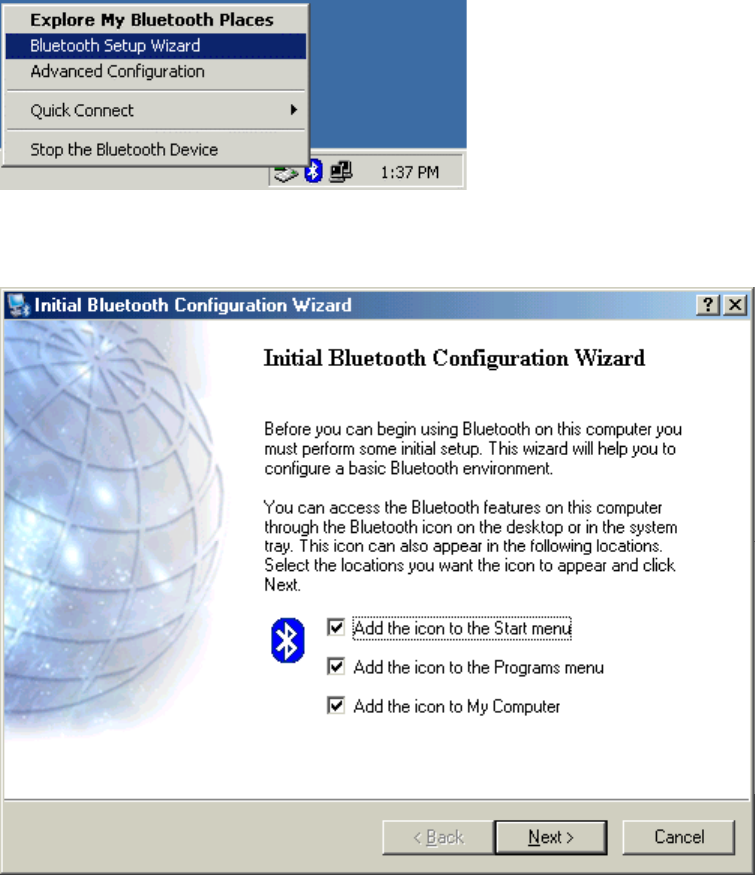
• Right-click My Bluetooth Places and select Bluetooth Setup Wizard or
• From the Bluetooth menu, select Bluetooth Setup Wizard
From the Windows system tray: right-click the Bluetooth icon and select
Bluetooth Setup Wizard.
(2) The "Initial Bluetooth Configuration Wizard" will pop up. Click "Next" to the
next page.
(3) Follow the wizard's on-screen instructions to configuration your Bluetooth
device.
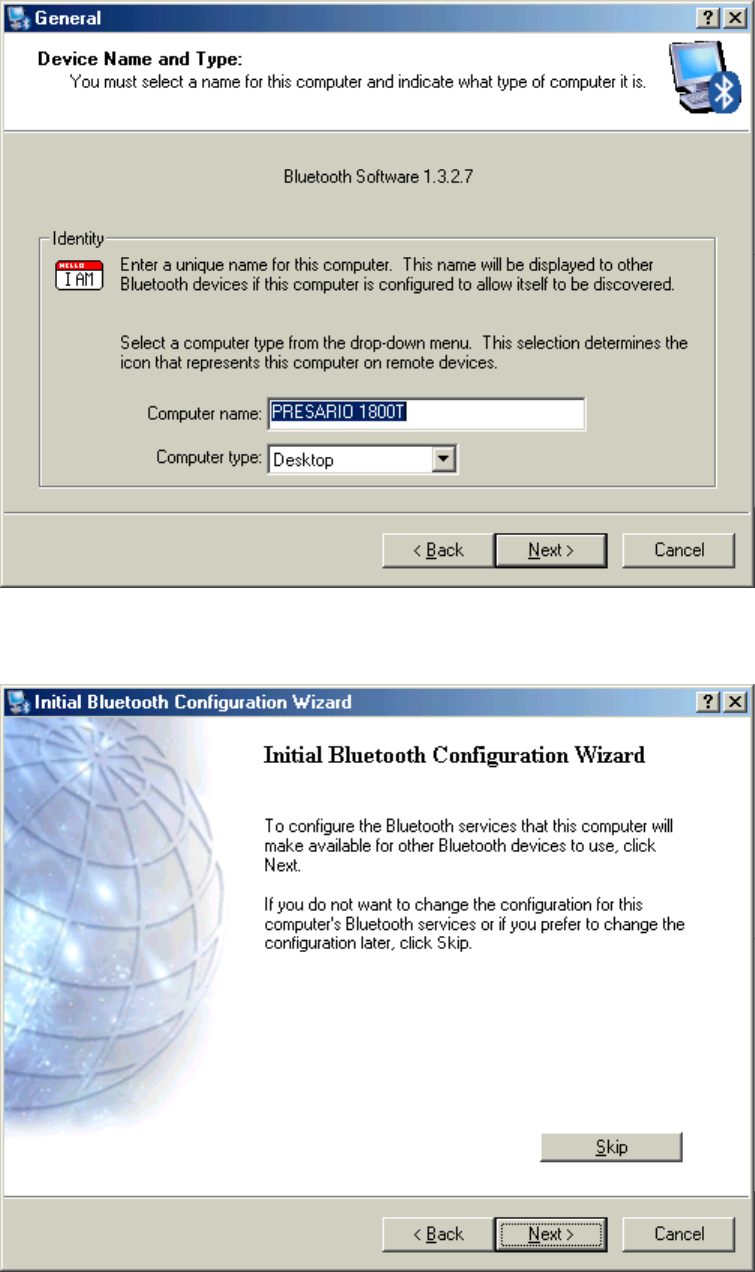
(4) Click "Next" to configure the Bluetooth service, you may skip the process
by clicking "Skip".
(5) Click "Next" to the next page.
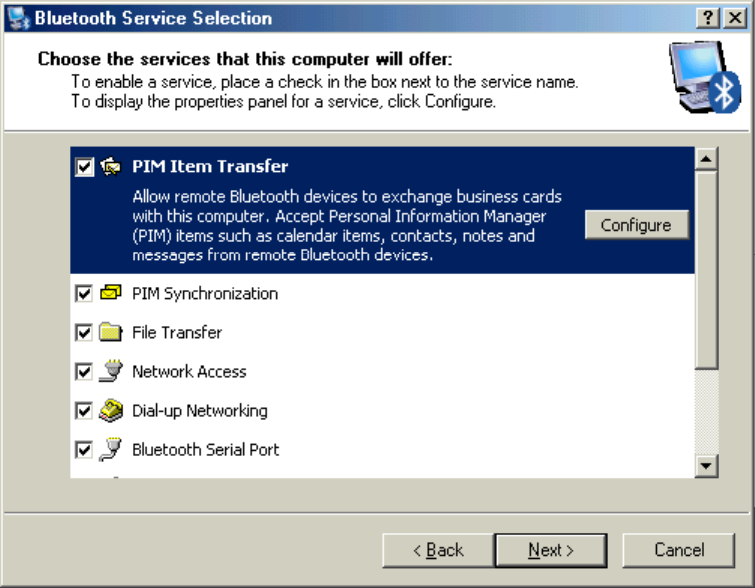
The services supported by Bluetooth are:
• Bluetooth Serial Port-a wireless connection between two devices.
This connection can be used by applications as though a physical serial
cable connected the devices.
• Dial-up Networking-allows a device to use a modem that is physically
attached to another Bluetooth device.
• Fax-allows a device to send a fax using a remote Bluetooth cell phone,
modem, or computer.
• File Transfer-allows a device to perform file system operations on
another Bluetooth device; browse, open, copy, etc.
• Headset-allows a Bluetooth headset to be used as the audio
input/output mechanism for another Bluetooth device, such as a
computer or cell phone.
• PIM Item Transfer-allows two Bluetooth devices to exchange Personal
Information Manager data such as business cards, calendar items,
email messages, and notes.
• PIM Synchronization-allows two Bluetooth devices to synchronize
Personal Information Manager data.
• Network Access-allows a device to access a Local Area Network via a
second Bluetooth device that is physically connected to the network or allows
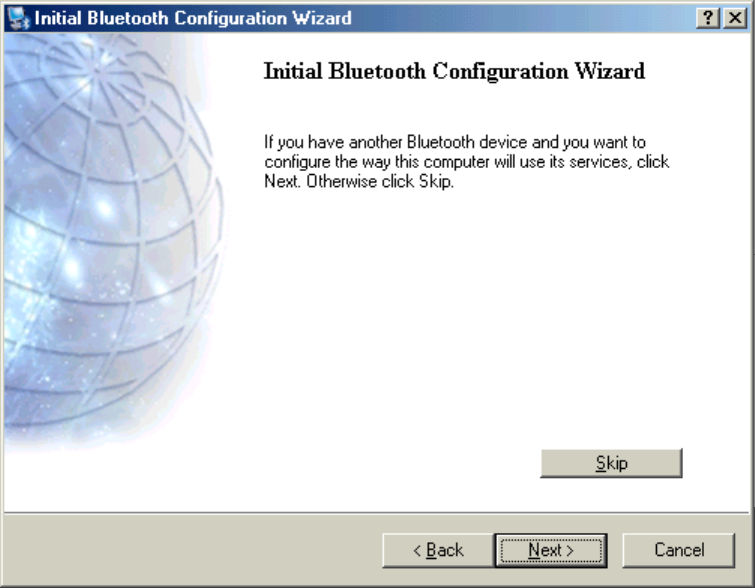
a remote device to become part of an ad hoc network provided by the
Bluetooth server.
• Audio Gateway-allows the microphone/speakers on Bluetooth device
(typically a computer) to be used as the audio input/output mechanism for a
remote Bluetooth device, such as a cell phone.
All Bluetooth servers do not necessarily provide all of these services. For
example, network gateways may provide only the Network Access service.
FIND A SERVICE
The process of determining the services that a device provides is called
Service Discovery.
You can follow the wizard's on-screen instructions to find a service to use or
click "Skip" button to skip this step.
To initiate a Service Discovery, in the Folders pane of My Bluetooth Places,
right-click a device name and select Discover Available Services from the shortcut
menu. Bluetooth services are those things that this computer can do for remote
Bluetooth devices. For example, if this computer allows a remote Bluetooth device to
send a fax using a fax modem that is physically attached to this computer, then this
computer is providing the Bluetooth fax service. Some services are hardware
dependant; this computer cannot provide the fax service unless it has a physical fax
modem, for example. Some Bluetooth services use virtual hardware. The Bluetooth
Serial Port service, for example, does not use a physical port on this computer. Instead,
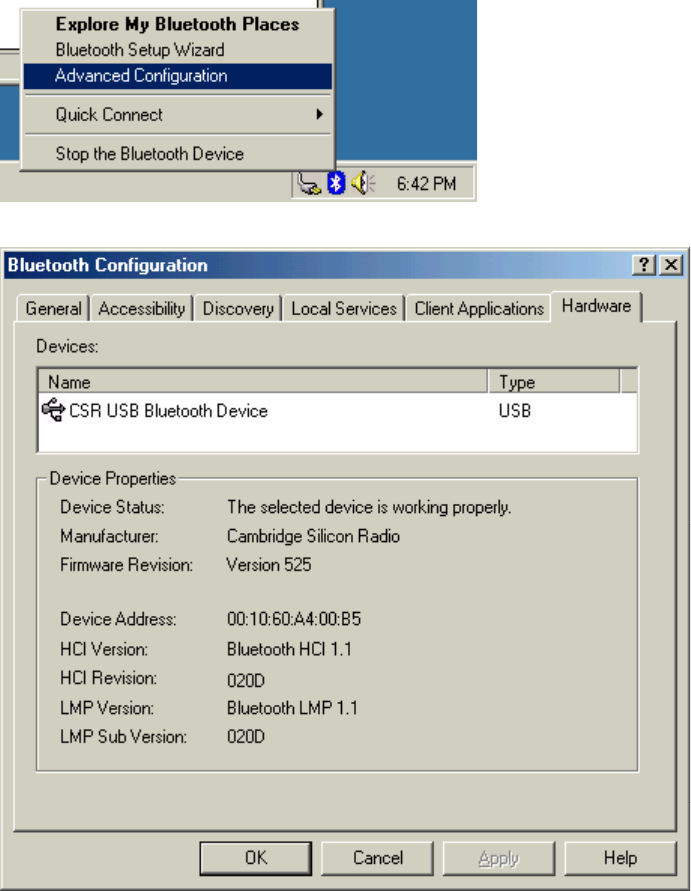
it creates virtual serial ports that Windows applications can see and use as if they were
actual physical ports. Each Bluetooth service that this computer is capable of
providing can be started automatically when Bluetooth starts. Each service can be
setup to require security measures before allowing a remote Bluetooth device to
connect. Bluetooth services require a Bluetooth application on the remote device;
services and applications usually have coinciding names; i.e., there is a Bluetooth Fax
Service and a Bluetooth Fax Application.
To check if you Bluetooth device is up and working properly
From the Bluetooth menu, select "Advanced Configuration".
Under the "Hardware" tab, verify the Bluetooth address is present along with
the driver and firmware version info.
If such information is not present, please unplug then plug in the USB adapter
to initiate the driver.

For CF Bluetooth card, please reboot the system with the CF Bluetooth card
securely inserted in the PCMCIA slot.
Repeat the installation steps for other USB adapters or CF card on other
PCs.
Periodic Search for Devices
Bluetooth can be configured to automatically search for devices on a regular
basis (Bluetooth Configuration Panel > Discovery tab). One of the advantages
of Bluetooth is the mobility that the wireless connections allow. However,
mobility means that devices may move in or out of connection range during the
time between the automatic updates performed by Bluetooth. To be certain
that the displayed list of devices in the neighborhood is current, or if automatic
periodic inquiry is not enabled, force an update of the device list using the
technique described in Search for Devices, above.
1.1 Icons used for Bluetooth devices and services
Bluetooth icons provide at-a-glance feedback about a device or service's
status by changing appearance.
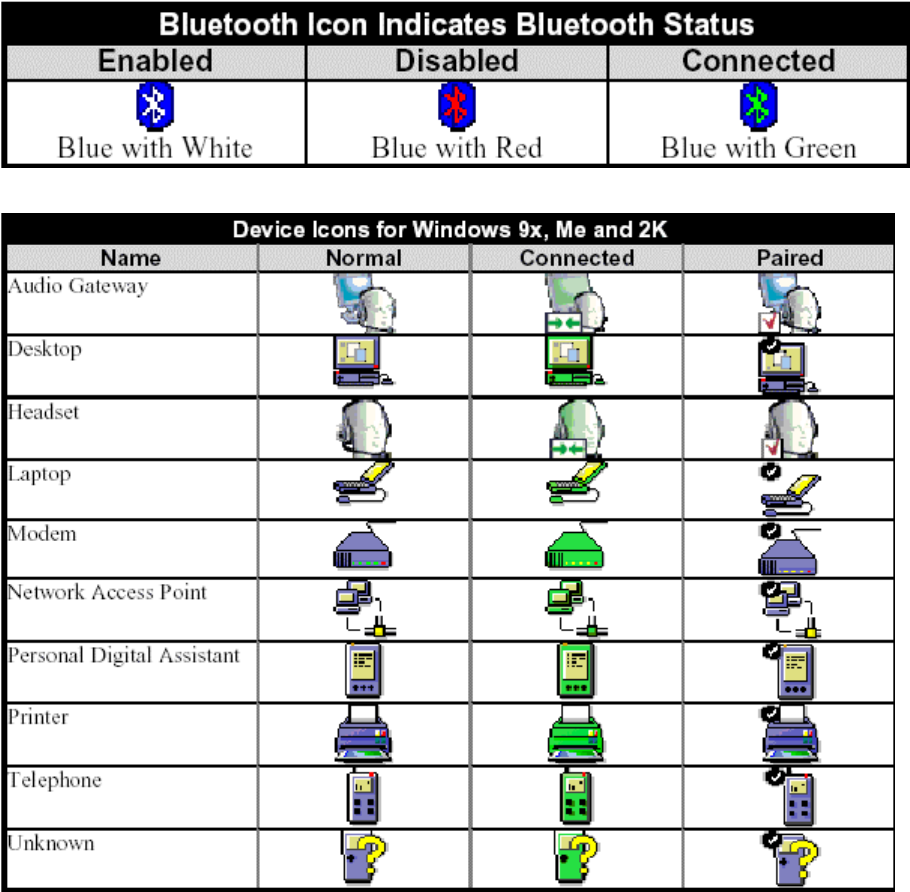
The Bluetooth icon in the Windows system tray provides feedback about
Bluetooth status.
Basic Bluetooth Icon
Device Icons for Windows 9x, Me and 2K
Service Icons for Windows 9x, Me and 2K
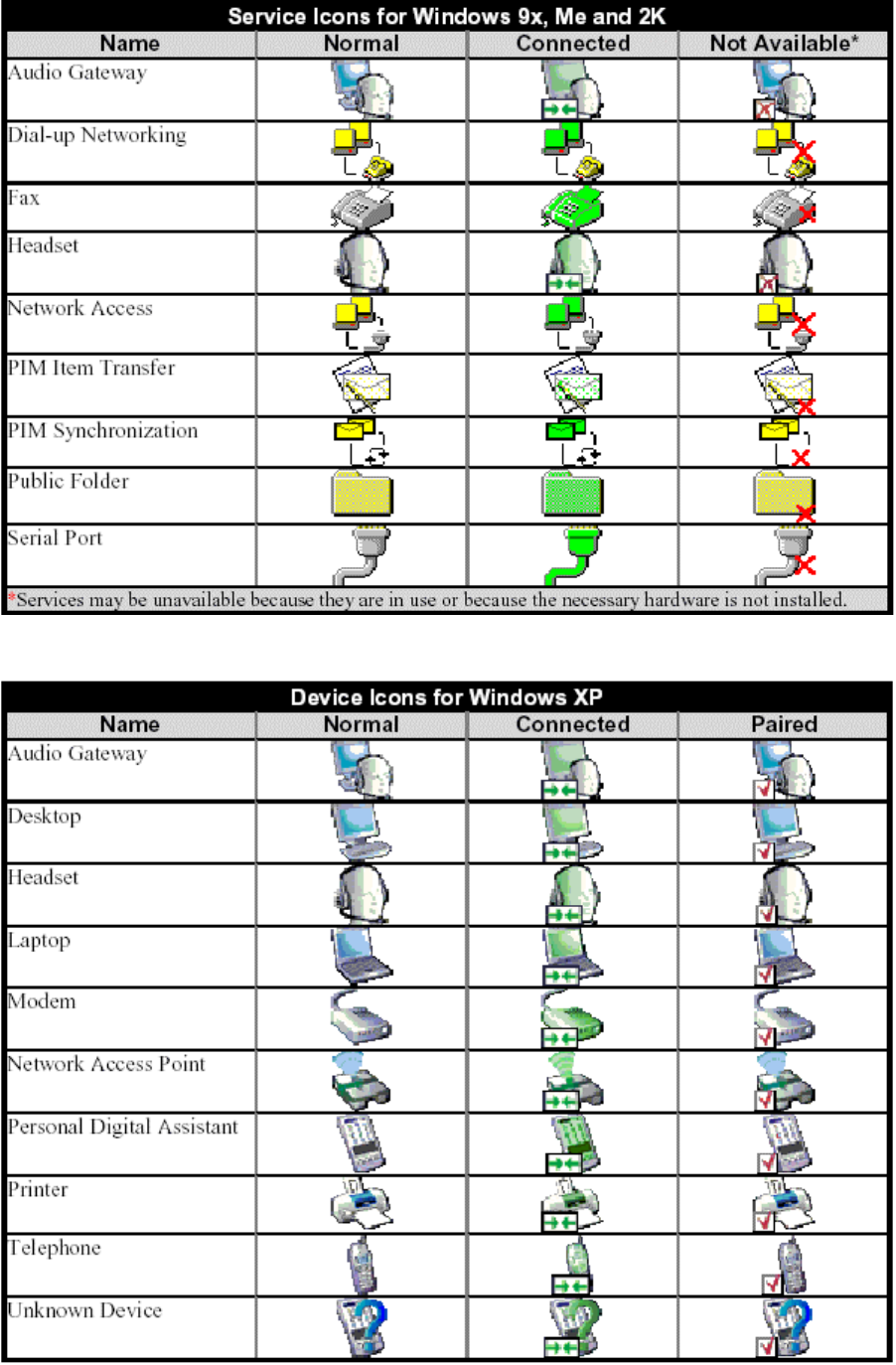
Device Icons for Windows XP
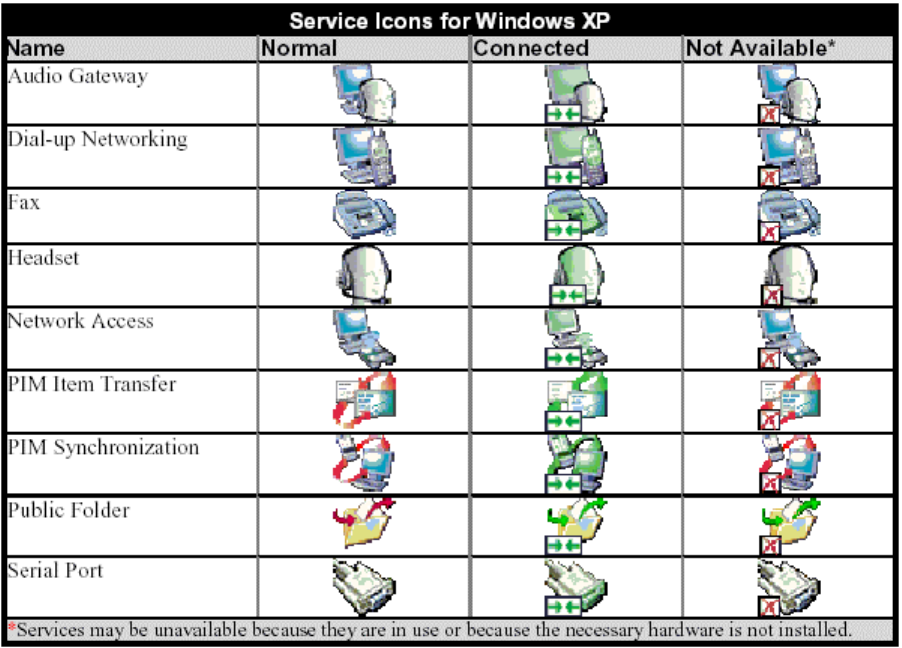
Service Icons for Windows XP
NOTE: Only available services are displayed in the menus.
2. Network sharing setting for Windows
The Network Access service permits a Bluetooth enabled PC (client) to access
the Internet via another Bluetooth enabled PC (Server) that already has
Ethernet connection.
Windows network sharing setting
PC to PC (Windows 2000 or Windows XP)
1. To enable Internet Connection Sharing on the server PC
2. Click on Start menu-->Settings -->Network and Dial-up Connections and
find your Local Area Connection (LAN) that is connected to the Internet.
3. Right click the active LAN connection to open the "Properties" dialog box.
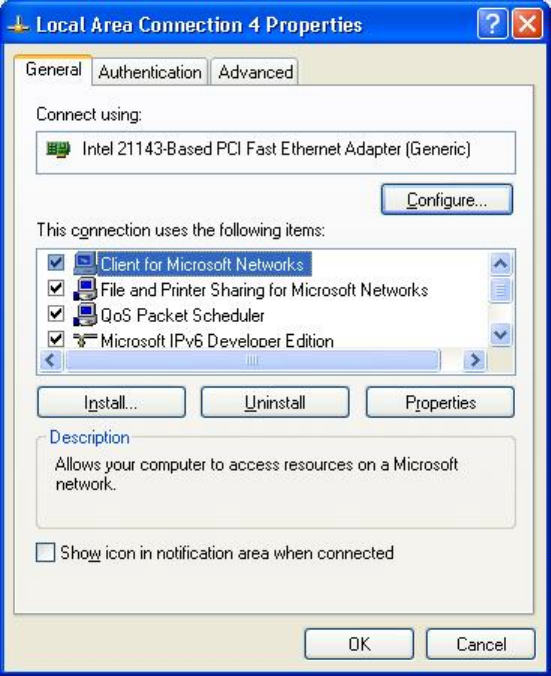
4. Click on "Advanced" tab and select the "Internet Connection Sharing",
checkbox to enable Internet sharing.
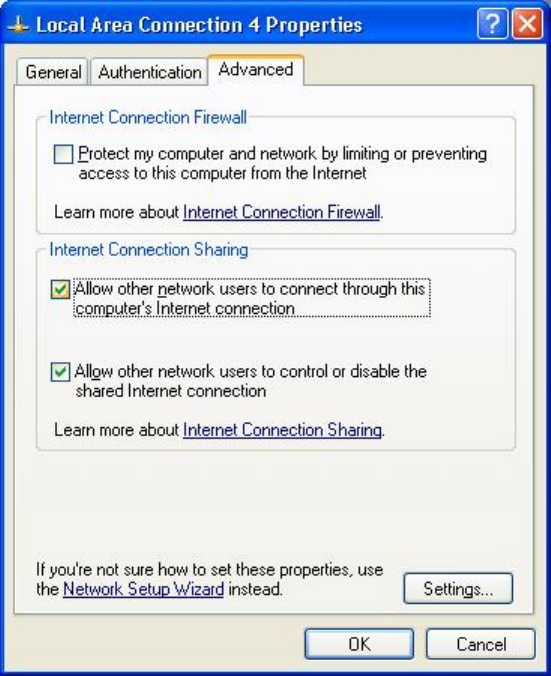
5. Click on "Settings..." button and select the services you wish to provide
other Bluetooth devices. Click "OK" to save the changes.
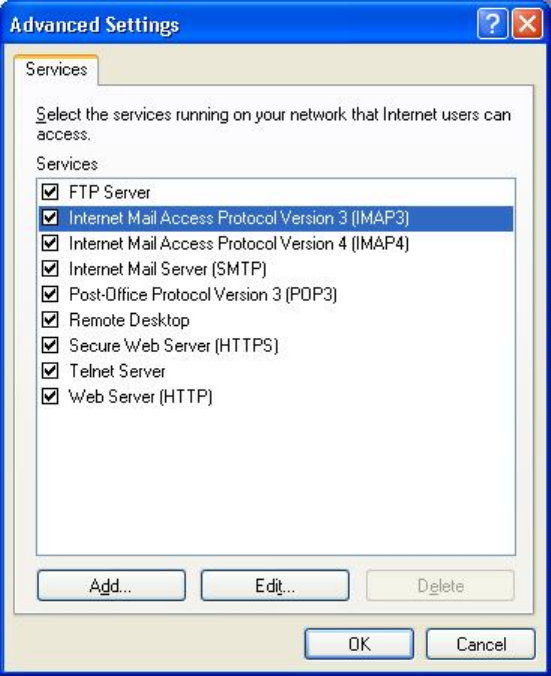
6. Go back to the "Network and Dial-up Connections" window, right click the
"Bluetooth LAN Access Server Driver" and select "Properties"..
7. Under "General" tab, click on "Internet Protocol (TCP/IP)" and
"Properties".
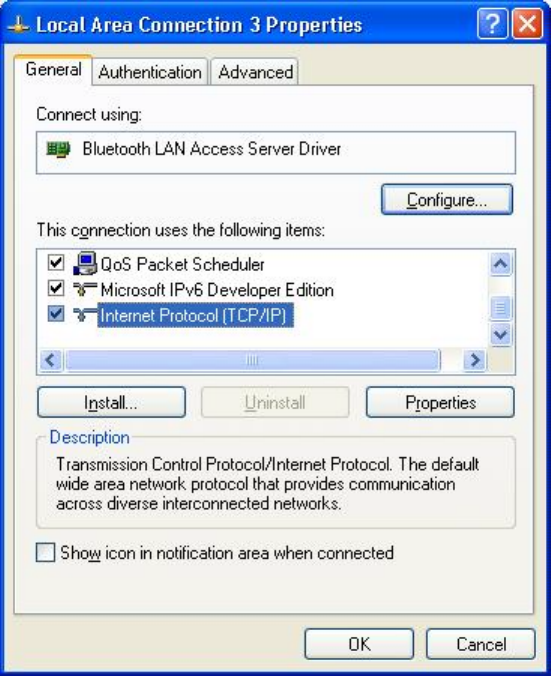
8. Under "General" tab, assign a virtual IP as shown in the picture
below. Then click "OK" to save the changes.
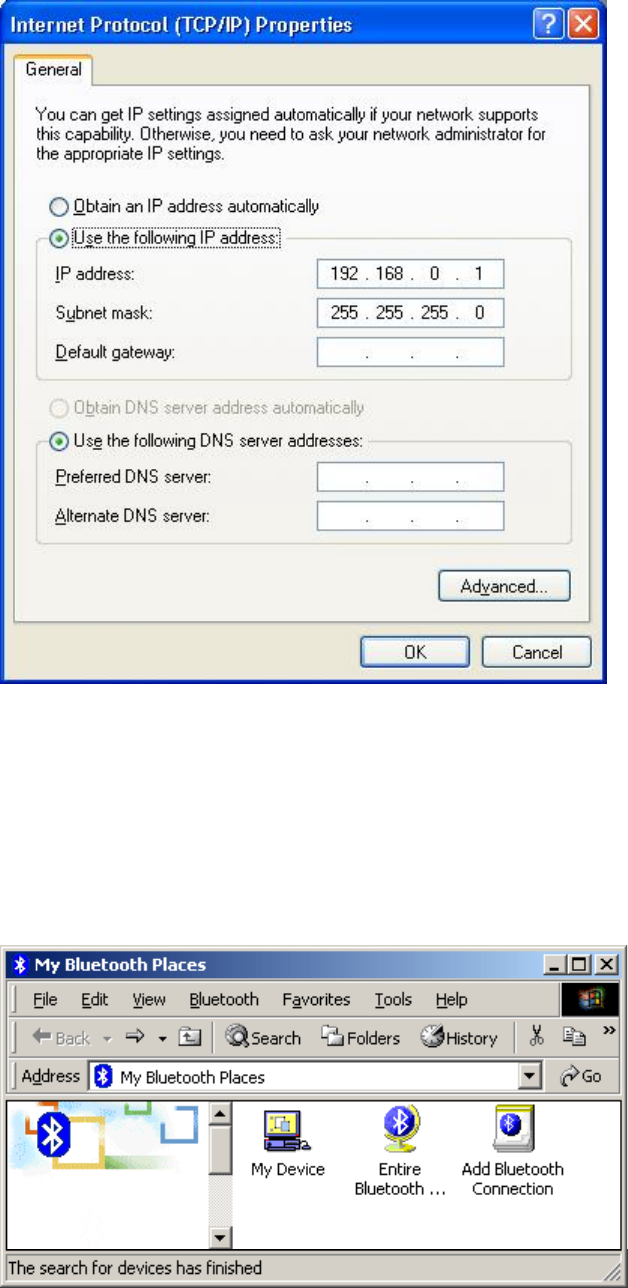
9. This allows the server PC to act as a DHCP server towards the client PCs.
NOTE: For Win98SE and WinMe, please download and install WinRoute
on the Server PC to allow DHCP service.
10. On the client PC, launch the Bluetooth software stack by clicking the "My
Bluetooth Places" icon located on the desktop.
11. Double click the "Entire Bluetooth Neighborhood" icon to search for
other Bluetooth devices nearby.
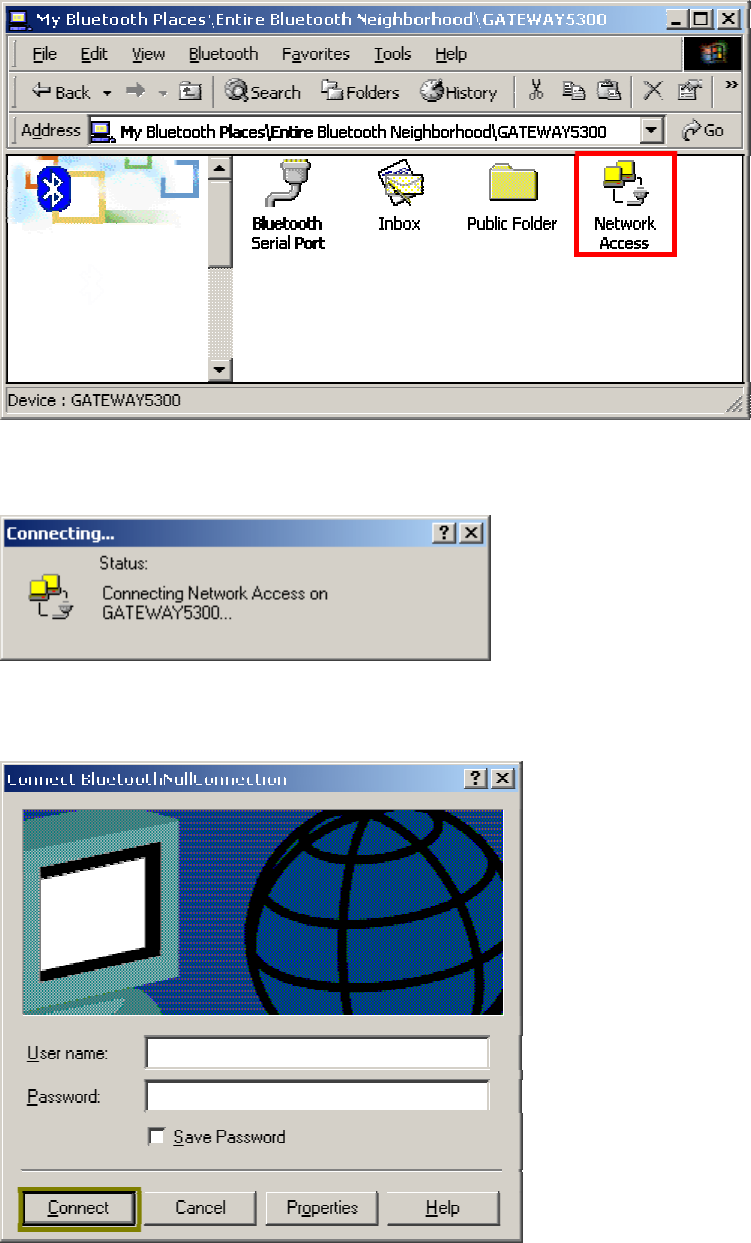
12. After searching is completed, locate the computer name of the server PC
and double click it to discover the Bluetooth services it has to offer. (i.e.
Bluetooth Serial Port, Dial-up Networking, File Transfer, Network Access, etc.).
13. Click on the "Network Access" icon to connect to the shared Internet
connection on the server PC.
14. Click OK without entering any username or password. If one is already
present, click OK anyway and it will still connect.
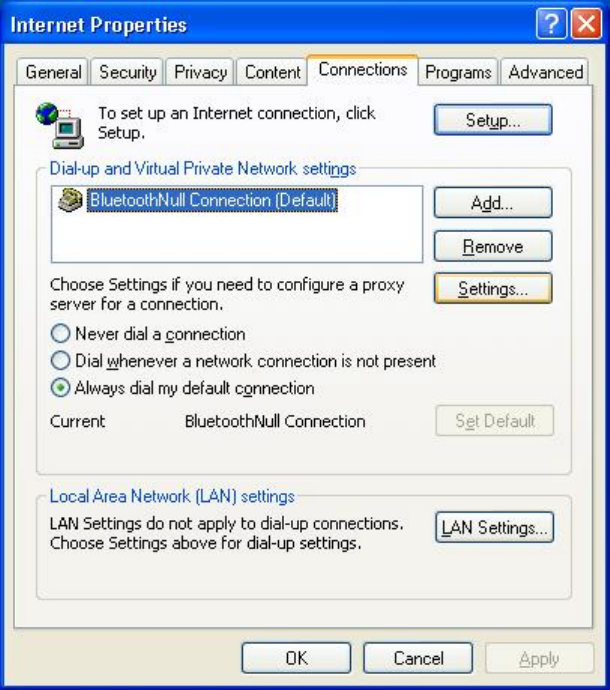
15. Now you can access the Internet via Bluetooth.
Note: If your PC accesses the Internet via a proxy server, remember to
configure the proxy setting of you browser program in the client PC.
Consult your MIS personnel if you're not sure what to set.
1. To set up proxy, right click "Internet Explorer", select "Properties", select
"Connections" tab. Select "BluetoothNull Connection" and click on
"Settings...".
2. Select the "Proxy server" checkbox and enter the proxy address of you
company and Port number.
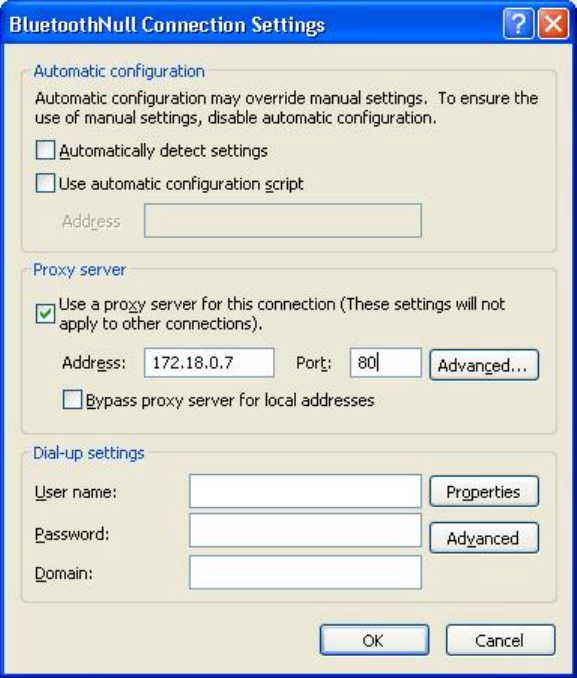
3. File transfer setting for Windows
The File Transfer service allows one Bluetooth device to perform file
operations on the default File Transfer directory (and the folders and files it
contains) of another Bluetooth device.
File transfer setting for Windows
PC to PC
1. After successful USB adapter setup on two PCs, launch the Bluetooth
software stack on both PCs by clicking the "My Bluetooth Places" icon
located on the desktop.
2. On one PC only, double click on "Entire Bluetooth Neighborhood" icon to
search for other Bluetooth devices nearby.
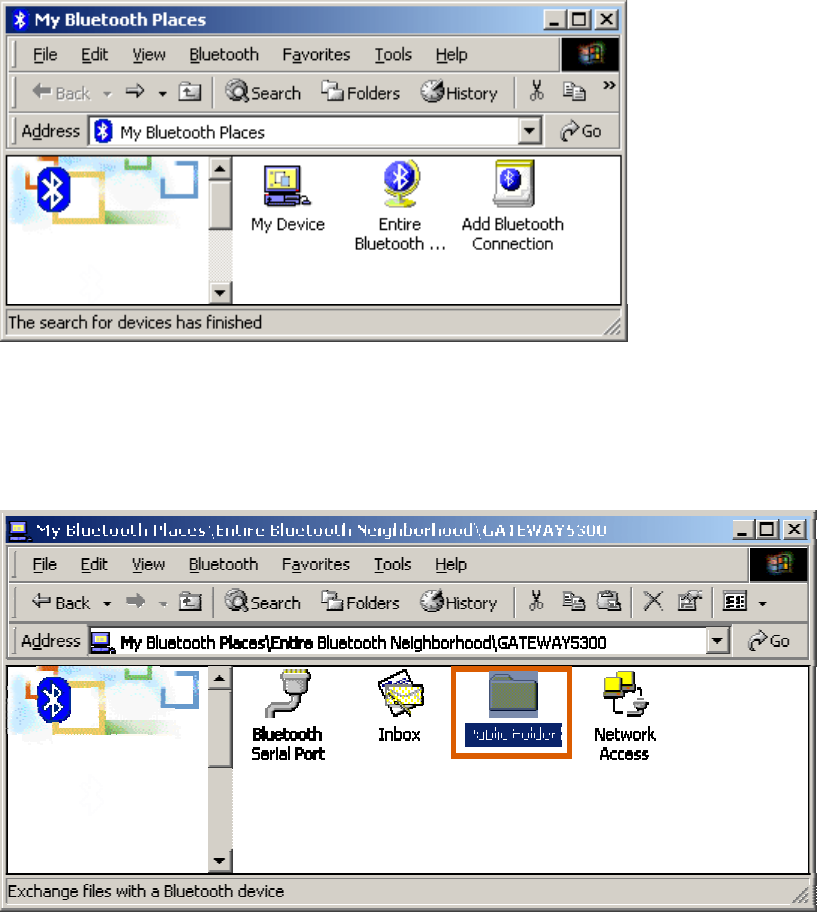
3. After searching is completed, locate the name of PC that you wish to
transfer the file to and double click it to discover the Bluetooth services it has to
offer (i.e. Bluetooth Serial Port, Dial-up Networking, File Transfer, Network
Access, etc.).
4. Double click the "Public Folder" icon to open the Bluetooth shared folder
on the other PC.
5. Locate the file you wish to transfer to that PC and drag it into the "Public
Folder" window.
6. At this time, a window will pop up to indicate that a file transfer connection is
being established, and then file transfer will begin.
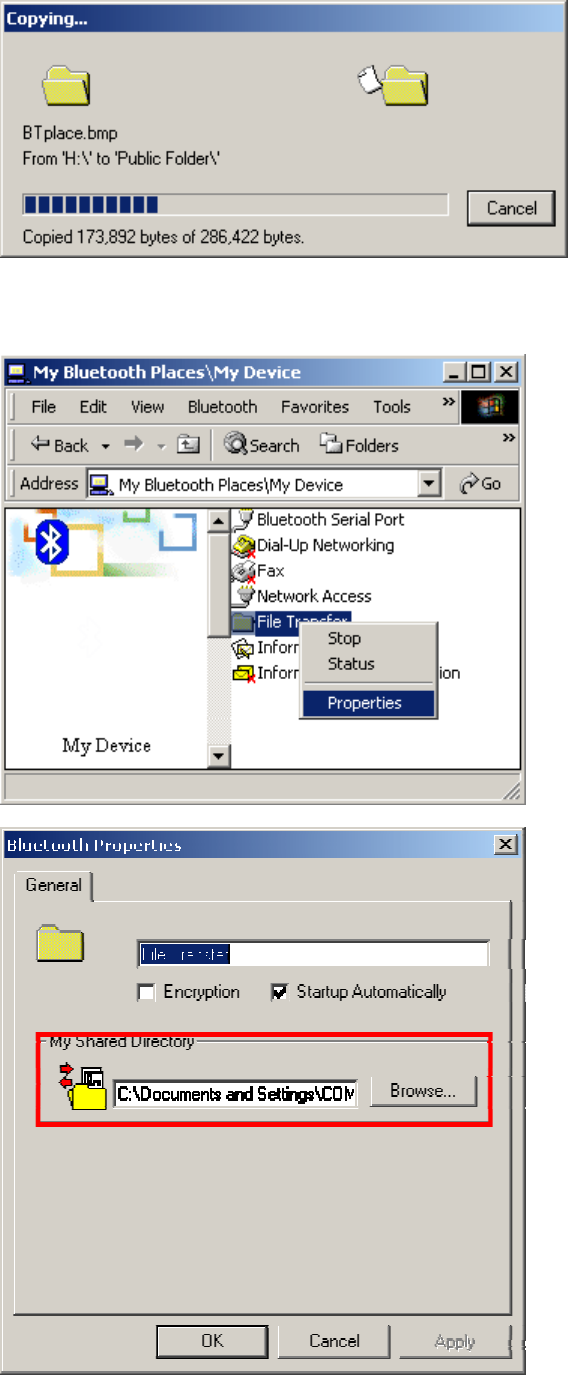
7. The file will be opened once the transfer is completed, if the "Start
Automatically" checkbox is selected.

4. Dial-up networking setting for Windows
The Dial-up Networking service permits a Bluetooth client to use a modem that
is physically connected to a different Bluetooth device (the server). After the
Bluetooth wireless connection is established the client can use the server's
modem as if it were a local device on the client.
To establish a Dial-up Networking session.
Dial-up networking setting for Windows
Connections are initiated from the client:
1. On the client, in the Folders pane of "My Bluetooth Places", select "Entire
Bluetooth Neighborhood".
2. In the right pane of "Entire Bluetooth Neighborhood", right-click
anywhere except on a device name and select Refresh from the pop-up menu.
3. In the Folders pane of "My Bluetooth Places", right-click the server that will
provide the Dial-up Networking Service and select Discover Available Services
from the pop-up menu to update the available services list. The available
services will be displayed in the right pane of "My Bluetooth Places".
4. In the right pane of "My Bluetooth Places", double-click "Dial-up
Networking".
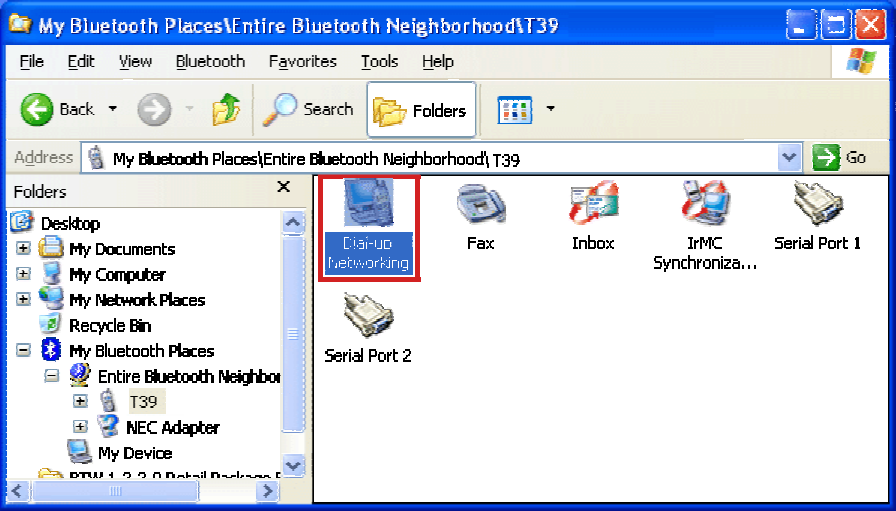
5. In the Connect To dialog box, type in your user name, password, and the
phone number to be dialed, and then click the "Dial" button.
6. Select the "Save password" checkbox and the dialog box will not appear for
subsequent connections to the same phone number. You can now open a web
browser and connect to the Internet.
Note: When using the GPRS Dial up function, you do not have to
type in the user name or password.
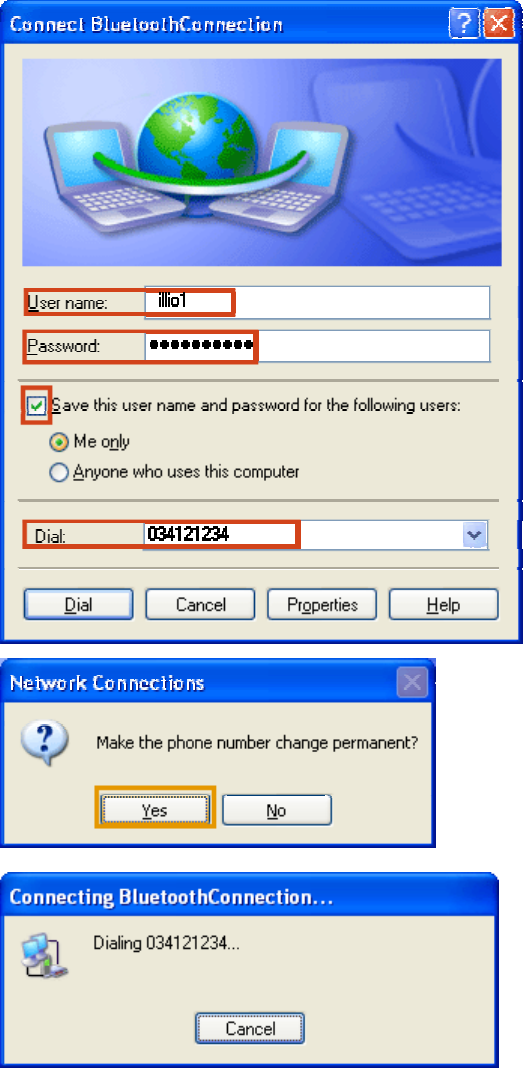
To close a Dial-up Networking connection
1. On the client, in the Folders pane of "My Bluetooth Places", select
(highlight) the device that is providing the Dial-up Networking service.
2. In the right pane of "My Bluetooth Places", right-click "Dial-up
Networking" and then select "Disconnect Dial-up Networking" from the
pop-up menu.
5. FAX setting
The Fax service allows a Bluetooth client to wirelessly send a fax using a
device that is physically attached to a Bluetooth server.
FAX setting for Windows
To send a Fax
Connections are initiated from the client:
1. On the client, in the Folders pane of "My Bluetooth Places", select "Entire
Bluetooth Neighborhood".
2. In the right pane of "Entire Bluetooth Neighborhood", right-click
anywhere except on a device name and select Refresh from the pop-up menu.
3. In the Folders pane of "My Bluetooth Places", right-click the server that will
provide the Fax service and select "Discover Available Services" from the
pop-up menu to update the available services list. The available services will
be displayed in the right pane of "My Bluetooth Places".
4. In the right pane of "My Bluetooth Places", double-click Fax. After the Fax
connection is established, open or create the document to be faxed and use
the "Print" or "Send to Fax Recipient" option available in most applications.
The Fax connection closes automatically when the transmission is completed.
6. PIM Item Transfer setting
Overview
The Bluetooth PIM Item Transfer application allows this computer to send and
receive Personal Information Manager items to-and-from a remote Bluetooth
device. Item transfer can be accomplished several ways:
To send, receive or exchange business cards:
1. From Windows Explorer, My Bluetooth Places, right-click the PIM Item
Transfer service on a remote device and select the appropriate option.
or
In the Windows system tray, right-click the Bluetooth icon, select Quick
Connect Business Card Exchange, select a device from the list, select the
appropriate option from the shortcut menu, and then click OK.
2. From Windows Explorer, My Bluetooth Places, highlight the PIM Item
Transfer service on a remote device, and then, from the Bluetooth menu on the
Windows menu bar, select the appropriate action.
In addition to the business card options listed above, you can also send Notes
(*.vnt), Email (*.vmg) and Calendar (*.vcs) items from this menu.